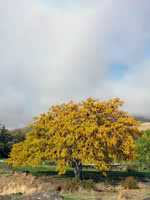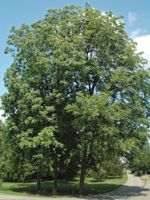Mon-Fri 9am - 5pm Mountain time
Thornless Honeylocust vs Hardy Pecan
Gleditsia triacanthos inermis
Carya illinoinensis
NOT AVAILABLE THIS SEASON - MIGHT RETURN
Thornless Honey Locust makes an excellent shade tree with its lacy foliage and dappled shade. The leaves are honey-yellow, light and airy, providing interesting color and texture to your landscape. This variety is thornless, and the seeds and pods provide food for wildlife such as deer and squirrels.
The Thornless Honey Locust is tolerant of drought, various soil conditions, and even road salt.
Hardy Pecan trees are known for their edible nuts that ripen in late autumn. They can be eaten raw or cooked and can be used in a wide range of baked goods. If stored properly in a cool, dry location, they can be kept for up to 6 months in their shell. Trees tend to bear nuts at maturity, which occurs around 6 -10 years. The size and form of this tree also makes it a great shade or feature tree for your landscape.
For nut production, it is recommended that at least 2-3 are planted so that cross pollination can occur. In colder areas it is likely that nut production will be limited, especially in locations with late frosts and shorter growing seasons.
If exposed to high winds, Hardy Pecan is known to lose branches, but these can be used as firewood, or to smoke foods with a hickory flavour. Finding seed or seedlings of this tree is rare in Canada.
Note: plant this tree once. It will not respond well to transplanting.

